The Angle of View of a lens, or what the lens “sees”, is an important element in photography. With the ubiquitous zoom lenses available today this is more a function of what we see in the viewfinder or on the screen, but for certain applications, such as 360° panoramic photography it is useful to actually know the Angle of View for a particular lens so that the number of shots, and their orientation, can be calculated.
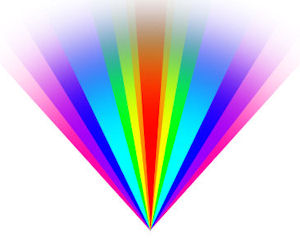 In the era of 35 mm Film photography, what the lens sees was expressed as the focal length of the lens. For example, a 24 mm or 28 mm lens is a Wide Angle lens, the 24 mm being more wide angle than the 28 mm, and a 200 mm or 300 mm lens is a Telephoto or Long lens, the 300 mm having a narrower Angle of View than the 200 mm.
In the era of 35 mm Film photography, what the lens sees was expressed as the focal length of the lens. For example, a 24 mm or 28 mm lens is a Wide Angle lens, the 24 mm being more wide angle than the 28 mm, and a 200 mm or 300 mm lens is a Telephoto or Long lens, the 300 mm having a narrower Angle of View than the 200 mm.
Although this was the convention, the Angle of View of lenses was often shown graphically, such as in the diagram on the right which shows the Angle of View for a 24 mm, 28 mm, 35 mm, 45 mm, 80 mm, 12 0mm, 200 mm and 300 mm lens when used with a 35 mm Film camera or FX format Digital camera.
With the advent of Digital photography came a variety of sensor sizes and formats resulting in the focal length of the lens becoming a meaningless number when considering its Angle of View, unless the sensor dimensions are known. The camera manufacturers, retailers and magazines adopted the convention of quoting the 35 mm equivalent so that those familiar with the lenses used for 35 mm Film cameras could relate to the Angle of View (e.g. focal length 5.2-26.0 mm (29-145 mm – 35 mm equivalent). This is fine for those who remember 35 mm Film photography! I feel however that a golden opportunity to adopt the convention of expressing what the lens sees as its Angle of View was missed. Quoting an Angle of View for a lens for a particular camera would mean that the knowledge of the lens focal length and sensor dimensions would not be necessary in order to understand what the lens sees.
Quoting the Angle of View still has a complication when it comes to calculating the number and orientation of images required for a 360° panorama because the convention is to quote the Angle of View across the diagonal of the image in the same way as TV and VDU screen sizes are expressed. The information we need for our 360° Panorama calculations are the angle subtended by the height and width of the image rather than the diagonal.
Theoretically, the Angle of View can be calculated using plane trigonometry. The focal length of the lens and half the dimension in the image forms a right angled triangle so that half the Angle of View = arctangent of half the dimension divided by the focal length.
AoV = 2 x (tan-1 ( ( d / 2 ) / f )
where d is the dimension in the image (e.g. diagonal, width, height)
e.g. For a 45 mm lens on a 35 mm camera where the diagonal = 43.3 mm, width = 36 mm and height = 24 mm, the respective Angles of View are 51.4°, 43.6° and 29.9°.
This formula works well for the longer focal lengths, but becomes unreliable as the focal length decreases and does not work at all for fisheye lenses, so I decided that the solution was to determine the values empirically. To do this I set out a semicircle of nails at 10° intervals and photographed them with a camera with a Nikon APS-C sensor (23.6 mm x 15.7 mm) and with the Nodal Point of the lens at the centre of the semicircle. The results are shown in the following table:
| Lens Angle of View Table | Diagonal | Long Side | Short Side |
| Sigma 8mm | (180°) | 180° | 115° |
| Nikon 10.5mm | 180° | 140° | 90° |
| Sigma 10-20mm @ 10mm |
110° | 98° | 74° |
| Sigma 10-20mm @ 20mm |
73.2° | 63.4° | 44.6° |
Comparing the calculated Angles of View with the measured values for the Sigma 10-20 mm zoom lens and the Nikon 10.5 mm fisheye lens shows that the values calculated trigonometrically for the rectilinear Sigma 10-20 mm lens are close enough to the measured values for determining the number and orientation of images for a 360° Panorama, but that we need the measured values when considering the fisheye lenses. The close correlation of the calculated and measured values for the Sigma 10-20 mm lens is due to the lens design and single front Nodal Point of this lens.
| Diagonal | Long Side | Short Side | ||
| Sigma 10-20 mm @ 20 mm |
Calculated | 70.6° | 61.1° | 42.9° |
| Measured | 73.2° | 63.4° | 44.6° | |
| Sigma 10-20 mm @ 10 mm |
Calculated | 109.6° | 99.4° | 76.3° |
| Measured | 110° | 98° | 74° | |
| Nikon 10.5 mm (Fisheye) | Calculated | 106.9° | 96.7° | 73.6° |
| Measured | 180° | 140° | 90° |
The following images show the difference between using the lenses with a 35 mm Film SLR camera (Nikon F80) and a DSLR with an APS-C sensor (Nikon D60). The lenses used to produce these images are designed for use with the DSLR sensor hence the severe vignetting on the images taken with the Nikon F80. The exception is the Sigma 8 mm fisheye, which produces a 180° full circle image when used with the 35 mm camera and a 180° Angle of View across the width of the image with the DSLR.
| 35mm Film Camera (Nikon F80) | APS-C Digital Camera (Nikon D60) |
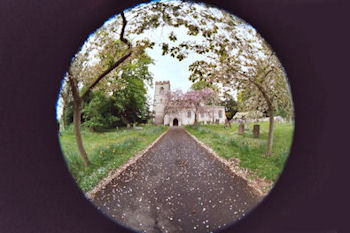 Sigma 8 mm Fisheye Lens |
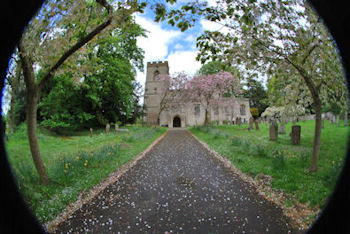 Sigma 8 mm Fisheye Lens |
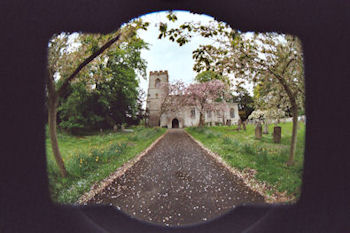 Nikon 10.5 mm Fisheye Lens |
 Nikon 10.5 mm Fisheye Lens |
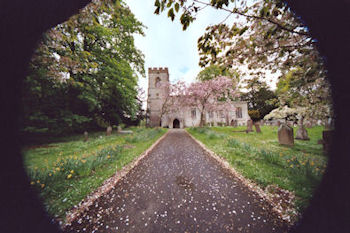 Sigma 10-20 mm Zoom Lens @ 10 mm |
 Sigma 10-20 mm Zoom Lens @ 10 mm |
 Sigma 10-20 mm Zoom Lens @ 20 mm |
 Sigma 10-20 mm Zoom Lens @ 20 mm |
 Sigma 30 mm Lens |
 Sigma 30 mm Lens |
The following images show the Angle of View for the Sigma 8mm and Nikon 10.5mm Fisheye lenses and the Sigma 10-20mm Zoom Lens set to 10mm then 20mm, for a DSLR with an APS-C sensor, at 10° intervals.
| Angle of View of Fisheye Lenses | Angle of View of Rectilinear Lens |
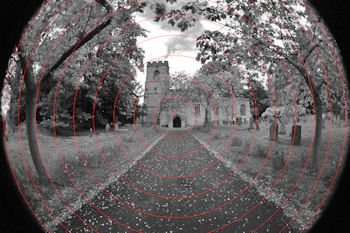 Sigma 8 mm Fisheye Lens |
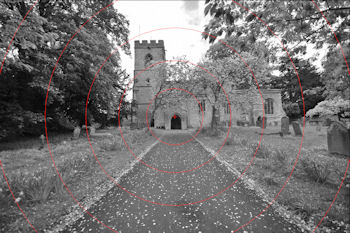 Sigma 10-20mm Zoom Lens @ 10mm |
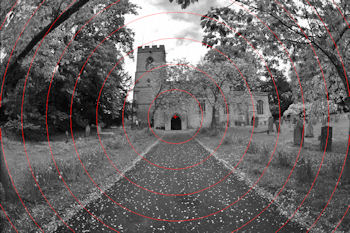 Nikon 10.5 mm Fisheye Lens |
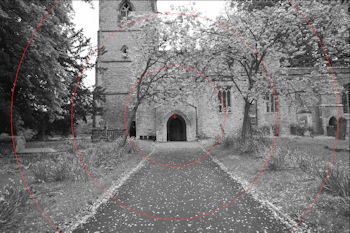 Sigma 10-20 mm Zoom Lens @ 20 mm |
